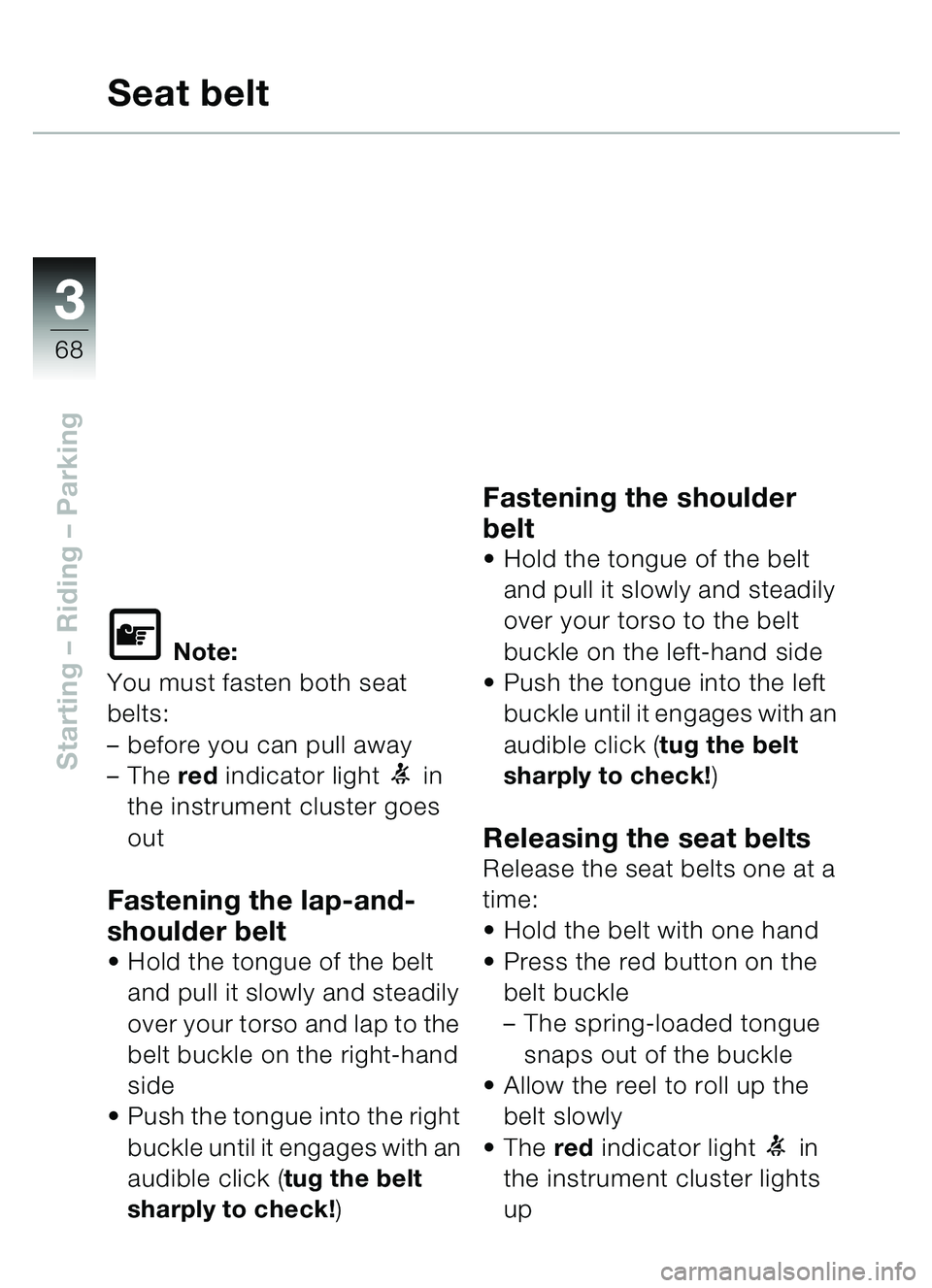Page 42 of 96
2
40
Safety check
Lights
Checking lights
e Important:
Always check that all lights are
in full working order before you
ride off.
\f Note:
If turn indicator repeater flashes
at twice the usual speed:
Defective flasher bulb.
Changing bulbs of parking
lights, low-beam and high-
beam headlight, rear light and
brake light: (
bService and
Technical Booklet, Chapter 2)
Headlight beam setting for
riding on left/right
If the BMW C1 is ridden in
countries where the opposite
rule of the road applies, its
asymmetric dipped beam will
dazzle oncoming traffic.
To avoid this form of dazzle,
cover the appropriate section of
the headlight glass with a mask.
Available from authorised
BMW dealers.
Your authorised BMW dealer
will be glad to provide any
assistance you may require.
( ) Figure in bracketsbpage number for
description
�� �
Page 43 of 96
2
41
Safety check
Lights
Map-reading light
d Warning:
Road safety legislation pro-
hibits the use of the map-
reading light while the vehicle
is moving - the light could dis-
tract other road users.
Adjusting beam throw
e Important:
Adjust the beam throw of your
headlight to suit load condition
only when the BMW C1 is sta-
tionary.
Have the headlight basic set-
ting adjusted by a specialist
workshop, preferably an
authorised BMW dealer.
\f Note:
Adjust beam height so that on-
coming traffic is not dazzled.
Make sure that the throw of the
light cone adequately illumi-
nates the road ahead of you.
�� �
Page 44 of 96
2
42
Safety check
Adjusting to suit load:
Place the BMW C1 on its
stand
– after making sure that the
ground is level and firm
Remove front fairing panel 2
(
b 21)
Turn screw 1 to adjust beam
throw
– turn counter-clockwise - =
shorter throw
– turn clockwise + = longer
throw( ) Figure in bracketsbpage number for
description
Lights
+-
1
2
�� �
Page 45 of 96
2
43
Safety check
Quick adjustment**• Place the BMW C1 on its stand
– after making sure that the
ground is level and firm
Remove front fairing panel 2
(
b 21)
** Optional accessory in conjunction
with rear seat
( ) Figure in brackets
bpage number for
description
Basic setting (one-up):
Move lever left 1 to position A
Adjusting to suit load:
– Light load (passenger up to 70 kg/154 lbs)
Move lever 1 forward to
position C
– Heavy load (passenger over 75 kg/165 lbs)
Move lever 1 right to
position B
Lights
12
C
BA
�� �
Page 46 of 96
2
44
Safety check
Windscreen washer system
d Warning:
Antifreeze for the washer sys-
tem is flammable. Keep it well
away from all sources of igni-
tion, store it in sealed con-
tainers and keep it out of
reach of children. Always fol-
low the instructions on the
container.
Topping up the
washer fluid
• Place the BMW C1 on its stand
– after making sure that the ground is level and firm
Remove front fairing panel 2
(
b 21)
Open quick-release fastener 1 on the headlight
and swing the headlight clear
( ) Figure in bracketsbpage number for
description
1
2
gg ,
Page 47 of 96
2
45
Safety check
Open filler 3 of the washer
fluid reservoir
– Move the cap clear
Refill with washer fluid
– Fill with water and - if neces-
sary - antifreeze in accord-
ance with the
manufacturer's instructions
– It is best to mix the washer
fluid before pouring it into
the reservoir
Close the washer-fluid reser-
voir
Swing the headlight back into
position and close the quick-
release fastener to secure
–Make sure that the head-
light is correctly secured
Install the front fairing panel
(
b 21)
( ) Figure in bracketsbpage number for
description
Windscreen washer system
3
�� �
Page 65 of 96
33
63
Starting – Riding – Parking
Running in
Running in new tyres
d Warning:
New tyres have a smooth sur-
face. This must be roughened
by riding in a restrained man-
ner at various heel angles
until the tyres are run in.
This running in procedure is
essential if the tyres are to
reach their maximum level of
grip.
Running in new brake
pads
d Warning:
New brake pads must “bed
down” and therefore do not
achieve their optimum friction
levels during the first 500 km
(approx. 300 miles).
This slight initial reduction in
braking efficiency can be
compensated for by exerting
greater pressure on the lever.
Try to avoid all unnecessary
hard braking applications
during this initial period.
gg ,
Page 70 of 96

33
68
Starting – Riding – Parking
Seat belt
\f Note:
You must fasten both seat
belts:
– before you can pull away
– The red indicator light
1 in
the instrument cluster goes
out
Fastening the lap-and-
shoulder belt
Hold the tongue of the belt
and pull it slowly and steadily
over your torso and lap to the
belt buckle on the right-hand
side
Push the tongue into the right
buckle until it engages with an
audible click ( tug the belt
sharply to check! )
Fastening the shoulder
belt
Hold the tongue of the belt
and pull it slowly and steadily
over your torso to the belt
buckle on the left-hand side
Push the tongue into the left
buckle until it engages with an
audible click ( tug the belt
sharply to check! )
Releasing the seat beltsRelease the seat belts one at a
time:
Hold the belt with one hand
Press the red button on the
belt buckle
– The spring-loaded tongue
snaps out of the buckle
Allow the reel to roll up the
belt slowly
The red indicator light
1 in
the instrument cluster lights
up
�� �